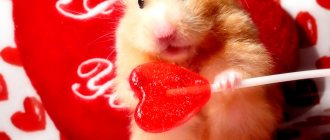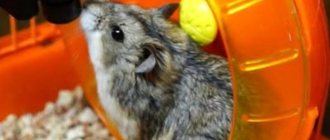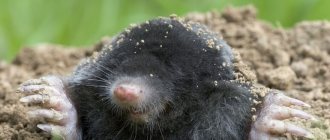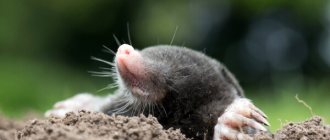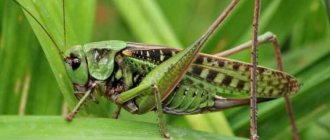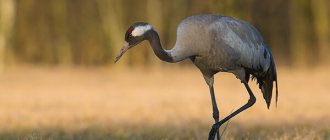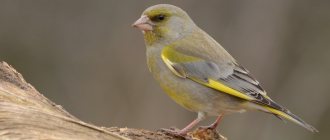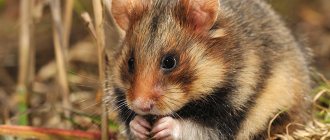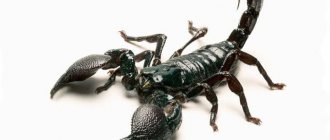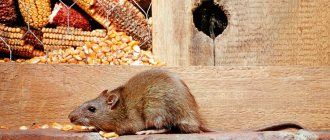Djungarian hamsters are part of the dwarf hamster family, belonging to the genus Hairy-footed. This species has distinctive features; their appearance is quite memorable. The rodents have a short tail, very furry legs and a dark stripe on their back.
The fur of the animal is speckled with white, this is due to the fact that in the wild the Djungarians live in the steppe area. They take refuge from predators by hiding in the snow and camouflaging themselves. This species has been well studied; there are many observations about the life of hamsters in their natural habitat.
Description
Author: Kristina Forlovskaya
Djungarian hamsters are small animals of the hamster family, the genus Hairy-footed. The body is covered with short, light gray fur. A darker stripe runs along the back; this is how Djungarian hamsters are usually recognized.
The paws are also covered with hair, but white. In clean pets they are a pleasant white-pink color. The ears are small and round. The beady eyes are slightly protruding. The body is small. The body length of an adult dwarf is 10 cm.
Sexual characteristics
It is quite difficult to examine sexual characteristics in a pet store if you have no experience communicating with such small animals. The seller can help. He can hold the animal so that it is comfortable to watch.
If the hamster is a boy, there is a gap of 0.5 cm between the genitals and the anus and there is a formation on the tummy that resembles a navel. If it is a girl, then the gap is almost invisible, and two stripes of papillae run along the tummy.
Kinds
As a result of selection, Djungarian hamsters with different colors and types of coat were bred.
Standard color
The back is gray-brown, with a dark stripe that runs from the head and tail. The belly and paws are white or light gray.
Pearl color
- Jungle animals
- Saber-toothed tiger
- 50 facts about kangaroos
- long eared hedgehog
- Cross spider
- Reptiles
This is a white Djungarian hamster. There is often a dark stripe on the back, although the color may be solid. With age, hamsters are able to change the brightness of their color: lighten or, on the contrary, become darker.
Mandarin
The body is orange, with a dark brown stripe on the back.
Campbell
Previously, the Campbell's hamster was considered one of the varieties of Djungarian hamsters. It turned out that these are still different species that are capable of producing hybrids. practically no different from Campbell. The only differences are in the structure of the fur: the Campbellbell hamster’s fur is disheveled and sticks out in different directions, while the Djungarian hamster’s fur is soft and smooth.
Where does the Djungarian hamster live?
Information about where dzhungariks live in the wild will help you better understand their lifestyle and habits. This species can be found in the steppe zone of Western Siberia, in the northeast of Kazakhstan, and in Asia. They live in areas undeveloped by humans.
Lifestyle
There is no hibernation period in winter. On the eve of winter, the hamster grows fat and stores food for future use. This small rodent digs long and deep burrows, which allows it to spend the winter warm. The active time of day is evening and night. They sleep during the day.
What Djungarian hamsters eat in natural conditions determines their diet when kept at home. In the steppe conditions where the Djungarian hamster lives, the food supply is quite simple. It consists of seeds and green parts of plants. The source of protein is small insects and their larvae.
It becomes clear what you need to feed your Djungarian hamster at home. There are subcutaneous pouches located on the sides of the body; they serve for storing and transporting food. Rodents spend most of their lives preparing food.
Gray hamster (Cricetulus migratorius)
Author: Gray Hamster
Author: Gray Hamster
Cell selection
The correct choice of cage will determine how many years a Djungarian hamster lives at home. You need to provide your pet with maximum comfort. The size of the cell is important. The hamster will feel great in a cage with the following overall dimensions:
- height – 47 cm;
- width – 36 cm;
- length – 50 cm.
How to arrange a cage
Does how long the Djungarian hamsters live in the house depend on how the cage is equipped? The dependence is direct. For a full life, a cage must have a house. There the pet will hide food and build a nest.
A wheel is required. Choose a less noisy one, otherwise it will be difficult to sleep at night. As soon as it gets dark outside, Djungarian hamsters at home begin to actively spin the wheel.
Ladders and multi-colored plastic tunnels are a must. The animal runs up the stairs, and the tunnel serves as a substitute for an earthen hole.
What do you need for feeding?
The Djungarian hamster receives food in dry form. To prevent food from scattering throughout the cage, you need a plastic or ceramic feeder. Size is important as hamsters fit into the food container and fill their cheek pouches.
A drinking bowl is required; it can be included in the kit that comes with the cage, but you can buy it separately. The volume of the drinking bowl is enough for several days. If the family spends the weekend away from home, there is no reason to worry about what to feed and water the Djungarian hamster at home. There will be enough water in the drinking bowl for several days, as well as food.
Which drinker is better
The choice is clear - you need an automatic drinker, which includes:
- plastic container;
- metal spout with a ball;
- fasteners (for fixing the sippy cup to the bars of the cage);
- tight-fitting tire.
It is not recommended to place open bowls of water in the cage. Dzungarik will certainly knock her over.
What do you need for feeding?
You should put a ball or vacuum drinker in the cage. The water needs to be changed every day for fresh water. You should not put a bowl of water in the cage. A Djungarian hamster can get wet in it, freeze and get sick. To accustom your hamster to a ball drinker, at first you can smear its spout with cucumber.
Since almost all Djungarian hamsters, which are widely distributed as pets, have an admixture of Campbell's hamster blood, Djungarian hamsters are also prone to diabetes. Only purebred Djungarian hamsters do not have this tendency, which are very difficult to acquire. Therefore, to prevent the disease, vegetables and fruits that contain a lot of sugar should be excluded from the rodent’s diet. These include: carrots, pumpkin, apples, peach, strawberries, raspberries, etc.
Don't give corn. There should be two feeders in the cage: one for dry food and the other for wet food. Dry balanced food can be bought in stores. Preference should be given only to high-quality, expensive food recommended by breeders. Cheap feeds are often unbalanced.
Cage care
Caring for the cage will not take much time. The tray must be filled with sawdust. Pet stores sell compressed sawdust. One pack lasts a long time. The sawdust will need to be renewed periodically.
You don't need to wash the cage very often. The animals are small and the bars of the cage remain clean for a long time. You need to remove and wash the wheel, house, drinking bowl, stairs, tunnels. You will have to vacuum the floor around the cage frequently. Djungarians actively stir up sawdust, building nests, and scatter food if there are family squabbles or they don’t like the food.
Communication
Djungarians have an independent character and are not too eager to communicate. To wean the animal from biting and fearlessly picking it up, it will have to be patiently tamed day after day. It will not be possible to raise a hamster once and for the rest of its life: if you do not have contact with it for 1-2 weeks, the pet will run wild again, and hand training begins all over again.
Keeping an animal with a nocturnal lifestyle means not disturbing it during daytime sleep, being content with communicating and observing it in the evening hours. You will have to endure noise at night: the hamster will run in a wheel, chew the bars of the cage and toys, dig for litter, rustle with paper in the house.
What to feed your Djungarian hamster?
Organizing a nutritious meal is quite simple. You need to go to the nearest pet supply store and find out the range of food for small rodents. You need to feed your Djungarian hamster at home with a feed mixture that includes:
- oat grain;
- sunflower seeds;
- peas;
- nuts;
- corn.
The most interesting thing is that with the same composition of the mixture, the animal eats food from one manufacturer, but not another.
Author: Kruze Victor
Treats
Djungarian hamsters do not live long at home (2.5-3 years) and you can brighten up their life in captivity with a treat. You can find sweet sticks (drops) in any pet store. Drops are made from natural grains and nuts. It is useful to pamper your pet with fresh vegetables and fruits:
- carrots;
- zucchini;
- cucumber;
- apple;
- banana.
What Djungarian hamsters eat fresh should not accumulate in the feeder. Complementary foods should be given by hand and in small quantities.
Author: Alexey Danlovsky
Protein for hamster
The care and maintenance of a Djungarian hamster will not be complete if there is no protein in the animal’s diet. A hamster should receive protein 2 times a week. It could be:
- chicken's meat;
- cottage cheese;
- boiled eggs.
There is an opinion that cheese is harmful to hamsters, but in practice, a small piece of mozzarella cheese does not adversely affect health. The fluffy ball usually flies from all its hamster legs to get its favorite delicacy.
Author: Ekaterina Gorbyl
Mineral feeding
There must be a mineral stone hanging in the cage. As many years as a Djungarian hamster lives, its teeth grow. By gnawing on a mineral stone, the hamster solves a dental problem - grinds down its incisors. In addition, the stone is needed for:
- for normal digestion;
- obtaining necessary microelements and vitamins;
- for a good mood.
Lifespan
A big problem when keeping a dwarf at home is the short lifespan of such a pet. The average lifespan of a Djungarian hamster, as a rule, does not exceed two or three years. Of course, there are cases when such a pet lived to the age of four years, but such “longevity” for a rodent in captivity is rather the exception than the rule.
Does a Djungarian hamster need to bathe?
To keep the animal's fur in good condition, traditional bathing with water is not required. Usually, Djungarians cope on their own; they actively clean their fur with their paws before and after eating. For variety, you can place a container of sand in the cage. Sand for bathing chinchillas is available for sale. One jar will last a long time.
Author: Vasily Prinersky
Does a Djungarian hamster need a mate?
There is an opinion that hamsters should be bought in pairs. It's a delusion. Hamsters prefer a solitary life. A partner is needed only for the mating period, and the rest of the time the female and male can live happily alone.
You must be prepared for daily fights if you decide to purchase two or more hamsters and keep them in the same cage. The battle for territory is usually accompanied by a loud squeak.
We can conclude that how many years Djungarian hamsters live at home absolutely does not depend on the presence of a partner. In most cases, the dwarf lives happily in its cage alone, and it doesn’t matter whether it’s a male or a female.
Author: Elizaveta Gaday
Author: Vasily Poklonsky
What does lifespan depend on?
The lifespan of a Djungarian hamster depends on various factors. The negative ones include:
- Place the cage in direct sunlight. The animal experiences severe stress from bright lighting, and overheating can lead to premature death.
- Frequent or constant noise.
- Swimming in the water.
- No load.
Favorable factors:
- Calm environment. The cage should be placed away from noise sources (TV, speakers), and access to the cage by other pets should be limited.
- Comfortable living conditions. Temperature range +21-25°C, humidity up to 60%. There should be no spoiled food in the cage. Hamsters tend to make supplies that quickly spoil.
- Physical exercise. A running wheel, labyrinths, and a tunnel must be installed in the cage.
- Taking a sand bath.
- Walking outside the cage. A special walking ball is suitable for these purposes.
Reproduction of Djungarian hamsters
If under natural conditions hamsters mate from March to September, then reproduction in captivity occurs all year round. Naturally, when individuals of different sexes come into contact.
Properly organized care and maintenance of hamsters at home requires the presence of several cages. The female and male live in different cages. The male is placed in a cage with the female for a short period of time. It only takes a few days for a female to become pregnant.
It is necessary to know how long pregnancy lasts in Djungarian hamsters in order to place the male in another cage in advance. Pregnancy lasts about 3 weeks. During this period, the female's behavior changes. She sets up a nest, fusses, stores food. If at this time the male is in the same cage with her, family scandals are inevitable. The squeak will be heard throughout the apartment.
A pregnant female needs to be given rest. Tell the children about her interesting situation and ask them not to pick her up.
How long does pregnancy last for a Djungarian hamster?
Females become sexually mature at 1.5 months. During the warm season (March-September) they mate several times and produce 3-4 litters. Pregnancy lasts 3 weeks.
Author: Pavel Moroz
What to feed during pregnancy?
For full reproduction, the Djungarian hamster (female) must receive food as usual, plus additional protein supplements in the form of meat, egg white and cottage cheese. This diet is maintained for the entire period of feeding the cubs.
Offspring
The maximum number of cubs is 10-11, but may be less. The cubs will be born blind, pink, and without fur. After just 10 days they become independent individuals and can serve themselves.
We must remember: you must not touch blind cubs. The female can eat such a baby. They also eat sick offspring, intuitively feeling that the cub is not able to live fully. When purchasing hamsters, you need to be prepared for such unpleasant moments.
Author: Vitaly Nalyvaichenko
Diseases of the Djungarian hamster
A hamster, like any living creature, can have health problems. You need to find out in advance what diseases can lie in wait for Djungarian hamsters. Signs your pet's health is deteriorating:
- dull or shiny coat;
- lack of appetite;
- reduced motor activity - the hamster runs a little, sits more.
Hamsters have different diseases. The animal may simply have a cold. A cold is accompanied by heavy breathing and wheezing. You can offer the dzhungarik fresh fruit. They improve immunity.
Mechanical injuries are possible. Hamsters are very mobile and can dislocate a paw if they fall badly. Suspicion of injury is a reason to take your hamster to the veterinarian for examination and consultation.
Weak spot of the eye. Hamsters have common conjunctivitis, which is treated with rinsing (chamomile tea, calendula). Age-related problems with the eyes that are not treated.
Djungarians sometimes have tumors, not to be confused with pregnancy and swollen sides due to cheek pouches stuffed with food. For any serious health problems, you should visit a veterinarian. How long Djungarian hamsters live depends on the owner.
Diseases of Djungarians
Representatives of this type of rodent sometimes get sick. The most common disease of the Djungarians is diabetes mellitus. The disease develops from poor nutrition, so it is necessary to carefully monitor your pet’s diet.
Wet litter and drafts can cause colds. In addition, “fluffies” can become infected with colds from their owners. To strengthen the immune system, it is advisable to give the animals fresh lettuce and parsley.
Typical diseases of the Dzungarians are intramural diseases. Moreover, if cataracts can appear closer to old age, then a young hamster can also get conjunctivitis, especially if its owner rarely cleans the cage.
An abundance of fatty foods increases the development of various tumors in rodents. The mechanism of their appearance has not yet been studied.
Sometimes furry animals suffer from skin diseases, which are accompanied by hair loss or dandruff. Skin ailments are caused by stressful situations in which a pet finds itself, or by individual intolerance to some substance.
An animal can be injured when falling from a height by sticking its paw between the bars of the cage. No pet is immune from dislocations and fractures.
Ticks and fleas cause parasitic diseases.
However, by following the principles of proper care and taking care of the cleanliness of your pet’s home, many diseases can be avoided. Caring owners will have a pet that looks cheerful and well-groomed. But if the animal’s behavior, the condition of its fur, or refusal to eat is evidence of a deviation from the norm, it is advisable to show the pet to a veterinarian.
How to choose and buy a Djungarian hamster?
Having learned everything about the care and maintenance of the Djungarian hamster, go to the pet store to buy one. What should you be interested in at this time, besides how much a Djungarian hamster costs? You need to decide for yourself how many animals you want to buy and whether you will breed.
Considering that hamsters do not live long, a maximum of 3 years, very rarely 4, you need to choose young hamsters. A good age for purchase is 3-4 months. Young hamsters get used to being handled more easily and become full-fledged partners for the child.
Author: Mikhail Reshetov
